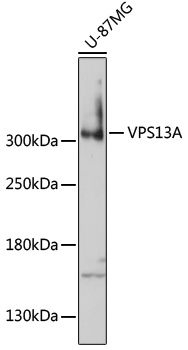Cell Biology Antibodies 7
Anti-VPS13A Antibody (CAB17419)
- SKU:
- CAB17419
- Product Type:
- Antibody
- Reactivity:
- Human
- Host Species:
- Rabbit
- Isotype:
- IgG
- Antibody Type:
- Polyclonal Antibody
- Research Area:
- Cell Biology
Description
| Antibody Name: | Anti-VPS13A Antibody |
| Antibody SKU: | CAB17419 |
| Antibody Size: | 20uL, 50uL, 100uL |
| Application: | WB |
| Reactivity: | Human |
| Host Species: | Rabbit |
| Immunogen: | Recombinant protein of human VPS13A. |
| Application: | WB |
| Recommended Dilution: | WB 1:500 - 1:2000 |
| Reactivity: | Human |
| Positive Samples: | U-87MG |
| Immunogen: | Recombinant protein of human VPS13A. |
| Purification Method: | Affinity purification |
| Storage Buffer: | Store at -20'C. Avoid freeze / thaw cycles. Buffer: PBS with 0.02% sodium azide, 50% glycerol, pH7.3. |
| Isotype: | IgG |
| Sequence: | Email for sequence |
| Gene ID: | 23230 |
| Uniprot: | Q96RL7 |
| Cellular Location: | |
| Calculated MW: | |
| Observed MW: | 360kDa |
| Synonyms: | CHAC, CHOREIN, VPS13A |
| Background: |
| UniProt Protein Function: | VPS13A: May play a role in the control of protein cycling through the trans-Golgi network to early and late endosomes, lysosomes and plasma membrane. Defects in VPS13A are the cause of chorea-acanthocytosis (CHAC); also known as Levine-Critchley syndrome. CHAC is an autosomal recessive neurodegenerative disorder characterized by the gradual onset of hyperkinetic movements and abnormal erythrocyte morphology. Basal ganglia atrophy in the brain is a pathological feature of the disease. Other clinical symptoms include psychiatric features, epilepsy, peripheral neuropathy, myopathy and oral self-mutilation. Belongs to the VPS13 family. 4 isoforms of the human protein are produced by alternative splicing. |
| UniProt Protein Details: | Chromosomal Location of Human Ortholog: 9q21 Cellular Component: extrinsic to membrane; intracellular Molecular Function:protein binding Biological Process: Golgi to endosome transport; locomotory behavior; nervous system development; protein localization; protein transport; social behavior Disease: Choreoacanthocytosis |
| NCBI Summary: | The protein encoded by this gene may control steps in the cycling of proteins through the trans-Golgi network to endosomes, lysosomes and the plasma membrane. Mutations in this gene cause the autosomal recessive disorder, chorea-acanthocytosis. Alternative splicing of this gene results in multiple transcript variants. [provided by RefSeq, Jul 2008] |
| UniProt Code: | Q96RL7 |
| NCBI GenInfo Identifier: | 66346672 |
| NCBI Gene ID: | 23230 |
| NCBI Accession: | NP_001018047.1 |
| UniProt Secondary Accession: | Q96RL7,Q5JSX9, Q5JSY0, Q5VYR5, Q702P4, Q709D0, Q86YF8 Q96S61, Q9H995, Q9Y2J1, |
| UniProt Related Accession: | Q96RL7 |
| Molecular Weight: | 28.5 kDa |
| NCBI Full Name: | vacuolar protein sorting-associated protein 13A isoform C |
| NCBI Synonym Full Names: | vacuolar protein sorting 13 homolog A (S. cerevisiae) |
| NCBI Official Symbol: | VPS13A |
| NCBI Official Synonym Symbols: | CHAC; CHOREIN |
| NCBI Protein Information: | vacuolar protein sorting-associated protein 13A |
| UniProt Protein Name: | Vacuolar protein sorting-associated protein 13A |
| UniProt Synonym Protein Names: | Chorea-acanthocytosis protein; Chorein |
| Protein Family: | Vacuolar protein sorting-associated protein |
| UniProt Gene Name: | VPS13A |
| UniProt Entry Name: | VP13A_HUMAN |
View AllClose







